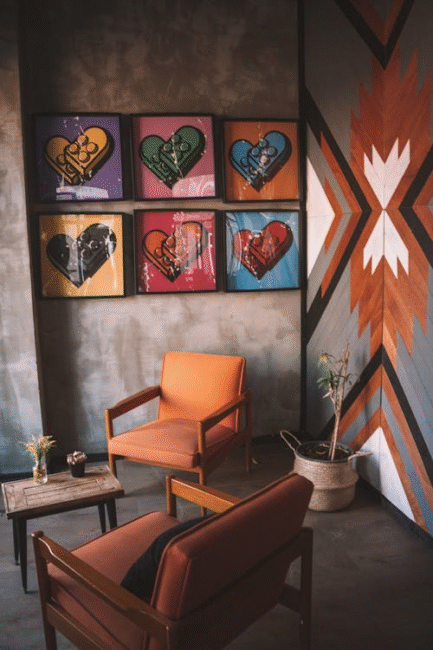
Art influences the entire feeling a space gives off. It provides rooms some character and sophistication, doing more than simply decorating them.
You can find comfort, tranquility, or stimulation through carefully chosen art. This effect, backed by science, shows art connects people to a stronger feeling of meaning and wellness.
However, the result varies with the type of room and art . Homeowners and designers both shape atmospheres by mixing style, color, and lighting to different parts of their home.
If you want to know how art helps create the ideal feeling for any moog, keep reading.
Identify the Mood You Want in Each Room
Every room offers a distinct feeling suited to its use. For example, your bedroom should feel peaceful, making nature art ideal options.
Contrast this with the living room, where bold abstract pieces or vibrant summer wall art inject energy and sparks social connection.
Family rooms thrive on large, impactful artworks with nature design that help create a sense of togetherness. A biophilic design-or one that integrates art with nature-helps reinforce emotional stability in children.
while quiet corners require soothing colors and gentle patterns. Home offices tend to demand relaxing art.
The key is to determine what emotion you want to feel whenever you are in that particular space.
A Quick Summary for Mood-Matching
Matching art to function rates harmony throughout the home. Here’s a table for your reference:
| Room Type | Matching Emotion/Feeling |
| Living Room | Friendly, energetic |
| Family Room | Cheery, relaxing |
| Bedroom | Calm in a relaxing and cozy |
| Kitchen | Energetic, yet focusing |
| Dining Room | Friendly, appetite-inducing |
| Relaxation Corner (reading, meditation, etc.) | Calm and inspiring, focusing, or cozy |
| Home Office | Calm in a focusing and motivating way |
Match Art Styles to Moods
Different artistic styles bring out unique feelings, so picking the right style is key for setting the mood. Post-impressionist pieces like Van Gogh’s intense, rich paintings, stir powerful emotions.
For unwinding, you can go for landscapes, ocean scenes, and plant prints to make the place more relaxing. Mandalas are great if you are into meditation.
Realistic art provides a timeless, dependable feeling. Personal elements like gallery walls combines art with photos, making the place feel more connected to your experiences, priorities, and identity.
Keep in mind that art showing negative subjects such as those depicting violence and chaos have uncertain effect on wellness.
You may also use travel mementos to add significance, linking memories to the place.
Abstract art ignites imagination and improves focus, making it perfect for active rooms or work areas. Adding accent colors add variety to sustain interest.
However, remember that excessive amounts of different colors can be cause eye strain. Keep accent colors at roughly 20% diverse to retain the vibrance and appea of the place without being overwhelming.
Another thing to take note of is to pick hues and tones that go well together.
Play with Color Psychology
Artists use deep colors mix warm and cool shades, producing balance and harmony. The key is to know how each color affects emotions.
Our eyes see color using receptors for red, green, and blue light, while your brain balances opposite signals to form vision.
Bright color schemes can help trigger joy, while softer tones alleviate low feelings by providing a mild contrast. Here’s a cheat list on how color psychology works:
- Soft blues and greens copy nature, quieting the mind.
- Neutrals like beige and gray create a peaceful and elegant vibe.
- Warm reds and oranges add lineliness but need careful use in areas meant for rest.
- Strong vivid colors encourage fun and creativity.
Matching color choices to what you like guarantees emotional impact and personal meaning through the house.
Before making significant color changes, note that personality also plays a part. Research says that people scoring high in agreeableness often like cool colors that increase positive feelings, whereas gentle midtones calm anxious, neurotic individuals.
You can use this to your advantage, especially when trying to neutralize a heated situation and evoke a positive emotion.
Use Seasonal Art to Refresh Ambiance
Changing art with the seasons being new energy into any room. This can help the setting fresh, stopping visual boredom while providing new viewpoints all year.
Winter could use comfortable, soft colors inviting warmth, while spring favors bright flowers and lively palettes reflecting new beginnings.
Summer’s energetic colors encourage vitality, while autumn’s deep, natural shades offer comfort and stability.

Beyond the seasons, shifts in mood or life events might inspire a desire for something different. These changes can include having a baby, moving houses, and other similar milestones.
This habits lets you refresh your home, matching nature’s and life’s cycles, while reflecting your personal changes.
Layer Art with Other Decor Elements
Art is more effective when thoughtfully layered with other decorations. Plus, there are many ways to implement this, giving you endless possibilities.
An example of this is the smart use of lighting. This is vital because light enables you and your visitors to see the artwork, especially at night. Warm yellow light builds a snug atmosphere, while cool blue light encourages calm.
How you show art matters, too. Spotlights set at the right angle also add dimension and intensity, while highlighting your pieces.
You can also explore different textures. Plush pillows or blankets invite ease. When combined with coarse sculptures or smooth canvases, it creates an interesting blend.
Aside from these, you can also explore scents, whether from dried flowers or essential oil diffusers. This adds a unique layer by utilizing another sense: the olfactory sense.
Creative placements and size variations also matter. Take advantage of the flow, your layout offers, as well as the nice harmony of different forms of art in various sizes.
Final Thoughts
Art is an essential tool for wellness.Remember, your living space reflects your inner world. Regularly interacting with intentional art boosts the chances of you getting a positive experience at home.
Pieces selected with care help support your spirit and helps you experience a range of emotions. With this, your home becomes a safe place that functions according to your needs.
